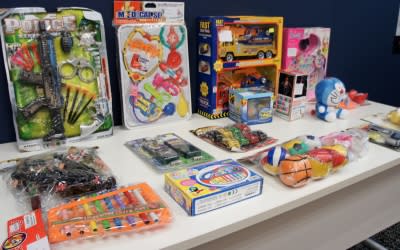Making sure toys in Singapore are safe

A recent test of 200 toys has found that 20 per cent of them were unsafe, said Spring Singapore.
The toys, tested in June and July this year, either failed the chemical toxicological test or the physical and mechanical test, or both.
Spring's tests, which cost the agency about S$1,000 per test, are conducted to check for the presence of excessive levels of lead and phthalates (plasticisers) which are harmful to the reproductive process, and also simulated normal use to ensure the toy was not potentially hazardous to the user.
The results, however, are an improvement from the tests by the Consumers Association of Singapore in July 2010 and February/March 2011, which found 48 per cent and 46 per cent, respectively, of the 50 toys sampled unsafe.
Spring has since issued a total of 47 stop-sale notices to retailers and suppliers whose toys were found to be unsafe. All toys were removed promptly, said Spring.
Commenting on the test findings, Spring Singapore's deputy chief executive Tan Kai Hoe, said, "There is some improvements but we want to do better."
With Singapore's market being "small and open" and the supply chains "diverse and complicated", ensuring toy safety is no simple matter, he said.
This is why Spring, which was appointed the Safety Authority in charge of Consumer Protection (Consumer Goods Safety Requirements) Regulations (CGSR) on 1 April, is setting up a joint working group to look into ways to further improve the safety of toys in Singapore.
The working group, comprising of representatives from Spring, Case, Singapore Toys & Confectionery Dealers' Association, Federation of Merchants' Associations, Singapore and the Singapore Retailers Association, will look to raise awareness and educate businesses and consumers.
It will also develop procurement and response plans for businesses.
Said Tan, "New products, new technologies, or new findings about the health or environmental hazards of some existing products of materials, means that some unsafe products could still find their way into the market, no matter how tight the regulations, how stringent the checks, how punitive the penalties or how rigorous the quality control."
"What's important is for us to be constantly on the lookout as new risks are identified and be able to respond swiftly to them," he noted.
While Case president Yeo Guat Kwang advised parents to buy "only well-made toys with proper labelling", the association said retailers are becoming more aware of the need for toy safety.
President of the Singapore Toys & Confectionery Dealers' Association Lim Cheng Eng said its 70 to 90 members are committed to comply with the CGSR.
The CGSR, applicable to all new consumer goods for private use, states that goods must conform to international, national or regional safety standards. If a product is found to be unsafe, the supplier must stop sale and notify consumers.
Failure to comply can result to a S$10,000 fine or up to two years jail or both.
"Those toys which failed the safety tests have been removed and we will make every effort to ensure that the toys we supply are safe," said Lim.
President of the Federation of Merchants' Associations, Singapore Yeo Hiang Meng told Yahoo! Singapore that by ensuring retailers are aware of the safety requirements of toys, suppliers will also be more careful to sell them safe products.

